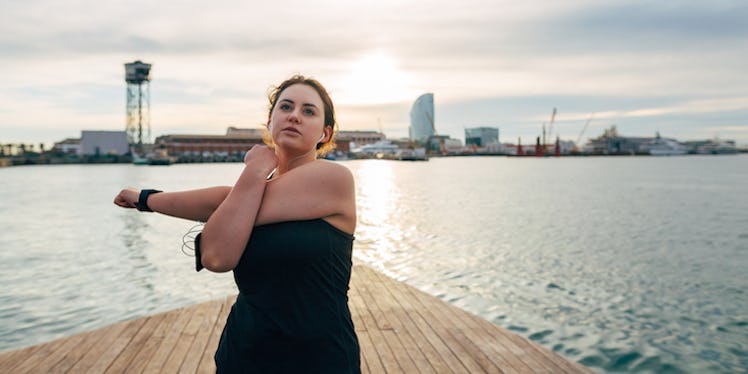
Here's How To Relax After A Workout When You Can Barely Even Move Your Body
There's nothing like the feeling you get when you finish an excruciatingly intense and challenging workout. Even though it seemed impossible to get through in the moment, you can't help but feel totally accomplished and proud of yourself once you're done — that is, until your muscles start aching, and you can barely even make it to the gym's exit. I'm not quite sure how you relax after a workout when it suddenly feels like you're lifting a car every time you have to go from sitting to standing, but I do know my body needs some relief ASAP.
I know I probably sound a little dramatic, but muscle soreness really can feel awful sometimes, especially when it gets to the point where you can barely even move your body. Whether you just completed a sweaty SoulCycle class, a challenging yoga flow, or a super intense HIIT circuit, achey muscles — more formally known as delayed onset muscle soreness (DOMS) — are often lurking right around the corner. According to the American College of Sports Medicine, DOMS usually starts around 12 to 24 hours after your workout "and may produce the greatest pain between 24-72 hours after the exercise has been performed." Lovely.
But the good news is this: Your body doesn't always have to be in horrible pain after every single workout. Yes, sore muscles are somewhat unavoidable to an extent, because your muscle fibers literally need to break down first before they can get stronger. But according to Men's Journal, while DOMS is "an indicator of a hard workout, it’s not necessarily the best indicator of a good workout." In other words, yes, you can expect to feel totally beat after trying a brand new workout that targets completely different muscles in your body, but if you feel that way all the time after sweating it out, your muscles — and you — won't ever get a chance to truly recover.
So yeah, at the very least, take comfort in the fact that DOMS isn't a constant struggle you'll have to deal with. And on those days when you can barely make it up to your fourth-floor apartment after a run, try some of these post-workout recovery techniques to soothe your muscles and your mind.
Try Out Foam Rolling
According to Dr. Armin Tehrany, NYPD honorary surgeon and founder of Manhattan Orthopedic Care, foam rolling doesn't just feel amazing after a hard workout; it can also help prevent injuries down the road. "Foam rolling specifically has many benefits, including reducing tension in the muscles and body, aiding in muscle recovery and blood flow, and it can also help with injury prevention," he tells Elite Daily.
If you work out regularly, Dr. Tehrany suggests foam rolling daily, anywhere from five to 20 minutes at a time. Ideally, he explains, foam rolling should be done both before and after your workouts — or really, he says, any time you're feeling muscle soreness or tension.
Move Through A Few Static Stretches
Dr. Tehrany also recommends static stretching as soon as you finish exercising. I know, I know — nobody wants to stay at the gym another 10 minutes after wrapping up a difficult workout. But if you want your body to feel its best, Dr. Tehrany says, it really is worth the effort. "After an intense workout, your body needs to wind down, and [this] important practice will ease muscle soreness and fatigue," he tells Elite Daily.
Static stretches include things like a quadriceps stretch, a seated forward bend, and even cobra pose in yoga, according to Livestrong. Try to hold these positions anywhere from 10 seconds to a minute to lengthen your muscles, increase flexibility, and get your body's blood flowing to aid in recovery.
Hop In The Tub And Soak As Long As You'd Like
A hot bubble bath isn't just a lovely form of self-care; it's also a great way to relax and restore your muscles after a demanding workout. According to Nicholas Licameli, PT, DPT, of Professional Physical Therapy, soaking in either an ice bath or a hot tub can reduce muscle soreness and help with performance during your workouts. If you want to get really into the whole process, Licaemli has all the specifics you need for the perfect post-workout bath. He told Bustle,
Use cold water immersion (8-15°C/46°F-59°F) for 5-15 minutes or alternate one to four minute bouts of cold and hot water (38°C-42°C/100°F-108°F). Be sure to be submerged to shoulder height.
Meditate For A Few Minutes
According to the Exploration of Consciousness Research Institute, meditation can significantly help relieve muscle pain and tension, not just because it's a peaceful, relaxing practice in general, but also because it can improve blood flow throughout your body, allowing your muscles to "freely move and function," and heal more effectively.
Try some mindful, deep breathing and meditation after your next workout to allow both your brain and your muscles an opportunity to relax and restore.